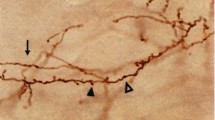Summary
-
1.
Presynaptic inhibition was examined at the synapses of identified interneurons in the crayfish brain.
-
2.
Descending interneurons can be excited by sensory stimuli to the head, thorax and caudal appendages. EPSPs can be elicited in these interneurons by ascending cells arising in thoracic ganglia (Fig. 1B). Conditioning shocks to cephalic sensory roots produce a 40 to 60% amplitude reduction in the EPSPs (Figs. 2, 4).
-
3.
The EPSP attenuation can be obtained under circumstances in which the conditioning shocks produce no observable postsynaptic action (Fig. 4).
-
4.
The terminals of the presynaptic ascending interneurons are easily penetrated. They exhibit depolarizing compound IPSPs in response to cephalic root stimulation (Fig. 5).
-
5.
The IPSPs exhibit reversal potentials (Fig. 6) and conductance changes (Fig. 7) similar to those reported in connection with primary afferent depolarization in crayfish abdominal ganglia.
-
6.
Action potentials actively invade the terminal region (Table 2) and are only modestly reduced (3–10%) by concurrent terminal IPSPs. It is possible that action potential attenuation may be much greater at synaptic release sites if conduction is passive in the finer terminal branches.
-
7.
Iontophoresis of GABA elicits depolarizing responses in ascending neuron terminals (Fig. 9). The GABA responses have properties similar to the synaptically elicited responses (Figs. 9, 10). Of particular note is the fact that GABA decreases the terminal input resistance by up to 70% but diminishes the presynaptic spike amplitude by less than 20%.
-
8.
It is concluded that presynaptic inhibition probably acts by mechanisms other than or in addition to the attenuation of the presynaptic action potential.
-
9.
It is also concluded that presynaptic inhibition in the brain prevents the summation of input from diverse sites and is therefore a mechanism for increasing the selectivity and temporal resolution of the large field sensory interneurons.
Similar content being viewed by others
Abbreviations
- cConn :
-
circumesophageal connective
- MHG :
-
medial hemigiant interneuron
References
Atwood HL, Bittner GD (1971) Matching of excitatory and inhibitory inputs to crustacean muscle fibers. J Neurophysiol 34:157–170
Atwood HL, Stevens JK, Marin L (1984) Axoaxonal synapse location and consequences for presynaptic inhibition in crustacean motor axon terminals. J Comp Neurol 225:64–74
Dudel J (1965) The mechanism of presynaptic inhibition at the crayfish neuromuscular junction. Pflügers Arch 284:66–80
Dunlop K, Fischbach G (1978) Neurotransmitters decrease the calcium component of sensory neurone action potentials. Nature 276:837–839
Frank K, Fuortes MGF (1957) Presynaptic and postsynaptic inhibition of monosynaptic reflexes. Fed Proc 16:39–40
Glantz RM (1978) Crayfish antennal neuropil. I. Reciprocal synaptic interactions and input-output characteristics of first order interneurons. J Neurophysiol 41:1297–1313
Glantz RM, Kirk MD, Viancour T (1981) Interneurons of the crayfish brain: the relation between dendrite location and afferent input. J Neurobiol 12:311–328
Glantz RM, Wang L, Waldrop B (1983) On the mechanism of presynaptic inhibition. Soc Neurosci Abstr 9:71
Kennedy D, Calabrase RL, Wine JJ (1974) Presynaptic inhibition: primary afferent depolarization in crayfish neurons. Science 186:451–454
Kennedy D, McVittie J, Calabrese R, Fricke RA, Craelius W, Chiapella P (1980) Inhibition of mechanosensory interneurons in the crayfish. I. Presynaptic inhibition from giant fibers. J Neurophysiol 43:1495–1509
Kirk MD, Wine JJ (1984) Identified interneurons produce both primary afferent depolarization and presynaptic inhibition. Science 225:854–856
Klein M, Kandel ER (1980) Mechanism of Ca++ current modulation underlying presynaptic facilitation and behavioral sensitization inAplysia. Proc Natl Acad Sci USA 77:6912–6916
Krasne FB, Bryan JS (1973) Habituation: regulation through presynaptic inhibition. Science 182:590–592
Martin AR (1955) A further study of the statistical composition of the end-plate potential. J Physiol 130:114–122
Martin AR (1977) Junctional transmission II. Presynaptic mechanisms. In: Kandel ER (ed) The nervous system (Handbook of physiology, sect 1). American Physiological Society, Bethesda, pp 329–355
Stewart WW (1978) Functional connections between cells revealed by dye coupling with a highly fluorescent Naphthalimide tracer. Cell 14:741–759
Van Harreveld A (1936) A physiological solution for fresh water crustacea. Proc Soc Exp Biol Med 34:428–432
Wang-Bennett L, Glantz RM (1985) Presynaptic inhibition in the crayfish brain. II. Morphology and ultrastructure of the terminal arborization. J Comp Physiol A (In press)
Wiersma CAG, Mill PJ (1965) Descending neuronal units in the commissure of the crayfish central nervous system; and their integration of visual, tactile and proprioreceptive stimuli. J Comp Neurol 125:67–94
Wilkens LA, Larimer JL (1973) Sensory interneurons: some observations concerning the physiology and related structural significance of two cells in the crayfish brain. Tissue Cell 5:393–400
Wojtowicz JM, Atwood HL (1984) Presynaptic membrane potential and transmitter release at the crayfish neuromuscular junction. J Neurophysiol 52:99–113
Author information
Authors and Affiliations
Rights and permissions
About this article
Cite this article
Glantz, R.M., Wang-Bennett, L. & Waldrop, B. Presynaptic inhibition in the crayfish brain. J. Comp. Physiol. 156, 477–487 (1985). https://doi.org/10.1007/BF00613972
Accepted:
Issue Date:
DOI: https://doi.org/10.1007/BF00613972




